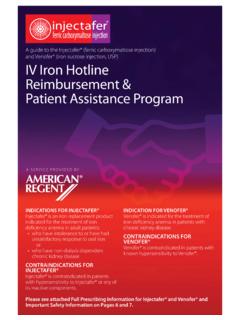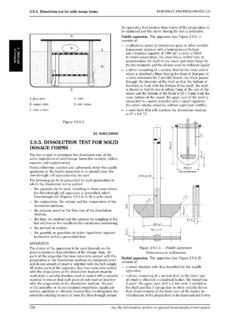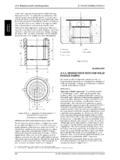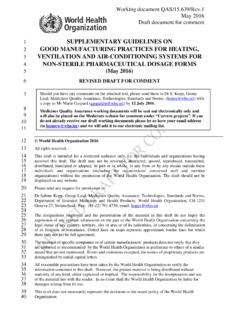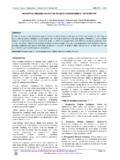Transcription of DOSAGE FORMS AN - Venofer
1 HIGHLIGHTS OF PRESCRIBING INFORMATION These highlights do not include all the information needed to use Venofer safely and full prescribing information for (iron sucrose injection, USP) Initial Approval: 2000------------------------------------ --------------------------- INDICATIONS AND USAGE ---------------------------------------- ----------------------- Venofer is an iron replacement product indicated for the treatment of iron deficiency anemia in patients with chronic kidney disease (CKD). (1)------------------------------------- ---------------------- DOSAGE AND ADMINISTRATION ---------------------------------------- -------------------PopulationDoseAdult patientsHemodialysis Dependent-Chronic Kidney Disease (HDD-CKD) ( )100 mg slow intravenous injection or infusionNon-Dialysis Dependent-Chronic Kidney Disease (NDD-CKD) ( )200 mg slow intravenous injection or infusionPeritoneal Dialysis Dependent-Chronic Kidney Disease (PDD-CKD) ( )300 mg or 400 mg intravenous infusionPediatric patientsHDD-CKD ( ), PDD-CKD or NDD-CKD ( ) mg/kg slow intravenous injection or infusion-------------------------------- -------------------------- DOSAGE FORMS AND STRENGTHS ---------------------------------------- ----------------- 10 mL single-use vial / 200 mg elemental iron (20 mg/mL) (3) 5 mL single-use vial / 100 mg elemental iron (20 mg/mL) (3) mL single-use vial / 50 mg elemental iron (20 mg/mL) (3)
2 ---------------------------------------- ------------------------- CONTRAINDICATIONS ---------------------------------------- ------------------------- Known hypersensitivity to Venofer (4) ---------------------------------------- ----------------- WARNINGS AND PRECAUTIONS ---------------------------------------- --------------------- Hypersensitivity Reactions: Observe for signs and symptoms of hypersensitivity during and after Venofer administration for at least 30 minutes and until clinically stable following completion of each administration. Only administer Venofer when personnel and therapies are immediately available for the treatment of serious hypersensitivity reactions. ( ) Hypotension: Venofer may cause hypotension. Monitor for signs and symptoms of hypotension during and following each administration of Venofer . ( ) Iron Overload: Regularly monitor hematologic responses during Venofer therapy. Do not administer Venofer to patients with iron overload.
3 ( )--------------------------------------- -------------------------- ADVERSE REACTIONS ---------------------------------------- ------------------------- The most common adverse reactions ( 2%) following the administration of Venofer are diarrhea, nausea, vomiting, headache, dizziness, hypotension, pruritus, pain in extremity, arthralgia, back pain, muscle cramp, injection site reactions, chest pain, and peripheral edema. ( )To report SUSPECTED ADVERSE REACTIONS, contact American Regent, Inc. at 1-800-734-9236 or FDA at 1-800-FDA-1088 or 17 for PATIENT COUNSELING INFORMATIONR evised: 8/2015 FULL PRESCRIBING INFORMATION: CONTENTS*1. INDICATIONS AND USAGE2. DOSAGE AND ADMINISTRATION Adult Patients with Hemodialysis Dependent-Chronic Kidney Disease (HDD-CKD) Adult Patients with Non-Dialysis Dependent-Chronic Kidney Disease (NDD-CKD) Adult Patients with Peritoneal Dialysis Dependent-Chronic Kidney Disease (PDD-CKD) Pediatric Patients (2 years of age and older) with HDD-CKD for iron maintenance treatment Pediatric Patients (2 years of age and older) with NDD-CKD or PDD-CKD who are on erythropoietin therapy for iron maintenance treatment3.
4 DOSAGE FORMS AND STRENGTHS4. CONTRAINDICATIONS5. WARNINGS AND PRECAUTIONS Hypersensitivity Reactions Hypotension Iron Overload6. ADVERSE REACTIONS Adverse Reactions in Clinical Trials Adverse Reactions from Post-Marketing Experience7. DRUG INTERACTIONS8. USE IN SPECIFIC POPULATIONS Pregnancy Nursing Mothers Pediatric Use Geriatric Use10. OVERDOSAGE11. DESCRIPTION12. CLINICAL PHARMACOLOGY Mechanism of Action Pharmacodynamics Pharmacokinetics13. NONCLINICAL TOXICOLOGY Carcinogenesis, Mutagenesis, Impairment of Fertility14. CLINICAL STUDIES Study A: Hemodialysis Dependent-Chronic Kidney Disease (HDD-CKD) Study B: Hemodialysis Dependent-Chronic Kidney Disease (HDD-CKD) Study C: Hemodialysis Dependent-Chronic Kidney Disease (HDD-CKD) Study D: Non-Dialysis Dependent-Chronic Kidney Disease (NDD-CKD) Study E: Peritoneal Dialysis Dependent-Chronic Kidney Disease (PDD-CKD) Study F: Iron Maintenance Treatment Dosing in Pediatric Patients Ages 2 years and Older with Chronic Kidney Disease16.
5 HOW SUPPLIED/STORAGE AND How Stability and Storage17. PATIENT COUNSELING INFORMATION* Sections or subsections omitted from the full prescribing information are not PRESCRIBING INFORMATION1. INDICATIONS AND USAGEV enofer is indicated for the treatment of iron deficiency anemia in patients with chronic kidney disease (CKD).2. DOSAGE AND ADMINISTRATIONV enofer must only be administered intravenously either by slow injection or by infusion. The DOSAGE of Venofer is expressed in mg of elemental iron. Each mL contains 20 mg of elemental Adult Patients with Hemodialysis Dependent-Chronic Kidney Disease (HDD-CKD)Administer Venofer 100 mg undiluted as a slow intravenous injection over 2 to 5 minutes, or as an infusion of 100 mg diluted in a maximum of 100 mL of NaCl over a period of at least 15 minutes, per consecutive hemodialysis session. Venofer should be administered early during the dialysis session. The usual total treatment course of Venofer is 1000 mg.
6 Venofer treatment may be repeated if iron deficiency Adult Patients with Non-Dialysis Dependent-Chronic Kidney Disease (NDD-CKD)Administer Venofer 200 mg undiluted as a slow intravenous injection over 2 to 5 minutes or as an infusion of 200 mg in a maximum of 100 mL of NaCl over a period of 15 minutes. Administer on 5 different occasions over a 14 day period. There is limited experience with administration of an infusion of 500 mg of Venofer , diluted in a maximum of 250 mL of NaCl, over a period of to 4 hours on Day 1 and Day 14. Venofer treatment may be repeated if iron deficiency Adult Patients with Peritoneal Dialysis Dependent-Chronic Kidney Disease (PDD-CKD)Administer Venofer in 3 divided doses, given by slow intravenous infusion, within a 28 day period: 2 infusions each of 300 mg over hours 14 days apart followed by one 400 mg infusion over hours 14 days later. Dilute Venofer in a maximum of 250 mL of NaCl. Venofer treatment may be repeated if iron deficiency Pediatric Patients (2 years of age and older) with HDD-CKD for iron maintenance treatmentThe dosing for iron replacement treatment in pediatric patients with HDD-CKD has not been iron maintenance treatment: Administer Venofer at a dose of mg/kg, not to exceed 100 mg per dose, every two weeks for 12 weeks given undiluted by slow intravenous injection over 5 minutes or diluted in 25 mL of NaCl and administered over 5 to 60 minutes.
7 Venofer treatment may be repeated if Pediatric Patients (2 years of age and older) with NDD-CKD or PDD-CKD who are on erythropoietin therapy for iron maintenance treatmentThe dosing for iron replacement treatment in pediatric patients with NDD-CKD or PDD-CKD has not been iron maintenance treatment: Administer Venofer at a dose of mg/kg, not to exceed 100 mg per dose, every four weeks for 12 weeks given undiluted by slow intravenous injection over 5 minutes or diluted in 25 mL of NaCl and administered over 5 to 60 minutes. Venofer treatment may be repeated if DOSAGE FORMS AND STRENGTHS 10 mL single-use vial / 200 mg elemental iron (20 mg/mL) 5 mL single-use vial / 100 mg elemental iron (20 mg/mL) mL single-use vial / 50 mg elemental iron (20 mg/mL)4. CONTRAINDICATIONS Known hypersensitivity to Venofer5. WARNINGS AND Hypersensitivity ReactionsSerious hypersensitivity reactions, including anaphylactic-type reactions, some of which have been life-threatening and fatal, have been reported in patients receiving Venofer .
8 Patients may present with shock, clinically significant hypotension, loss of consciousness, and/or collapse. If hypersensitivity reactions or signs of intolerance occur during administration, stop Venofer immediately. Monitor patients for signs and symptoms of hypersensitivity during and after Venofer administration for at least 30 minutes and until clinically stable following completion of the infusion. Only administer Venofer when personnel and therapies are immediately available for the treatment of serious hypersensitivity reactions. Most reactions associated with intravenous iron preparations occur within 30 minutes of the completion of the infusion [see Adverse Reactions ( and )]. HypotensionVenofer may cause clinically significant hypotension. Monitor for signs and symptoms of hypotension following each administration of Venofer . Hypotension following administration of Venofer may be related to the rate of administration and/or total dose administered [See DOSAGE and Administration (2), Warnings and Precautions ( ), and Adverse Reactions ( )].
9 Iron OverloadExcessive therapy with parenteral iron can lead to excess storage of iron with the possibility of iatrogenic hemosiderosis. All adult and pediatric patients receiving Venofer require periodic monitoring of hematologic and iron parameters (hemoglobin, hematocrit, serum ferritin and transferrin saturation). Do not administer Venofer to patients with evidence of iron overload. Transferrin saturation (TSAT) values increase rapidly after intravenous administration of iron sucrose; do not perform serum iron measurements for at least 48 hours after intravenous dosing [See DOSAGE and Administration (2) and Overdosage (10)].6. ADVERSE REACTIONSThe following serious adverse reactions associated with Venofer are described in other sections [See Warnings and Precautions ( , and )]. Adverse Reactions in Clinical TrialsBecause clinical trials are conducted under widely varying conditions, adverse reaction rates observed in the clinical trials of a drug may not reflect the rates observed in Reactions in Adult Patients with CKDThe frequency of adverse reactions associated with the use of Venofer has been documented in six clinical trials involving 231 patients with HDD-CKD, 139 patients with NDD-CKD and 75 patients with PDD-CKD.
10 Treatment-emergent adverse reactions reported by 2% of treated patients in the six clinical trials for which the rate for Venofer exceeds the rate for comparator are listed by indication in Table 1. Patients with HDD-CKD received 100 mg doses at 10 consecutive dialysis sessions until a cumulative dose of 1000 mg was administered. Patients with NDD-CKD received either 5 doses of 200 mg over 2 weeks or 2 doses of 500 mg separated by fourteen days, and patients with PDD-CKD received 2 doses of 300 mg followed by a dose of 400 mg over a period of 4 1. Treatment-Emergent Adverse Reactions Reported in 2% of Study Populations and for which the Rate for Venofer Exceeds the Rate for ComparatorAdverse Reactions (Preferred Term)HDD-CKDNDD-CKDPDD-CKDV enofer (N=231) % Venofer (N=139) %Oral Iron (N=139) % Venofer (N=75) %EPO* Only (N=46) %Subjects with any adverse and Labyrinth DisordersEar DisordersAbdominal Disorders andAdministration Site ConditionsAstheniaChest painFeeling abnormalInfusion site pain or burningInjection site extravasationPeripheral and InfestationsNasopharyngitis, Sinusitis, Upperrespiratory tract infections, , Poisoning and ProceduralComplicationsGraft and Nutrition DisordersFluid and ConnectiveTissue DisordersArthralgiaBack painMuscle crampMyalgiaPain in System , Thoracic andMediastinal DisordersCoughDyspneaNasal and Subcutaneous Tissue * EPO=ErythropoietinOne hundred thirty (11%)


